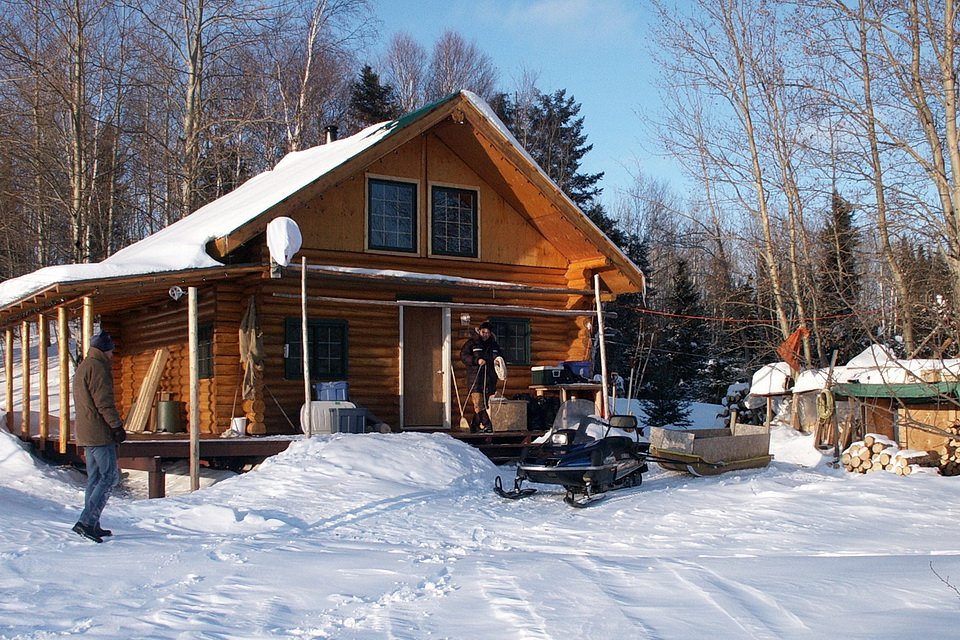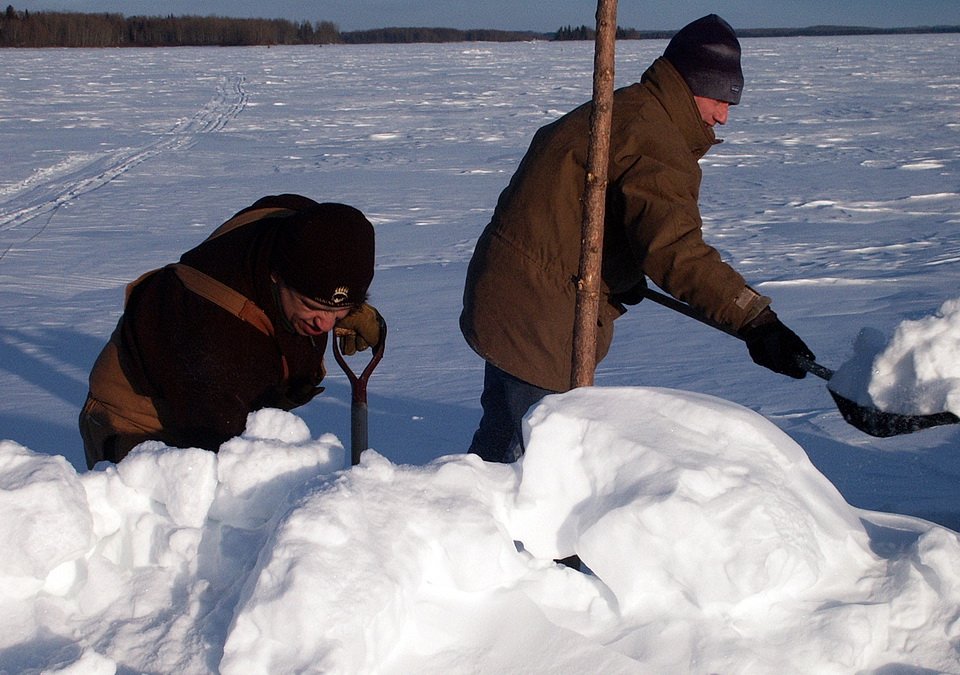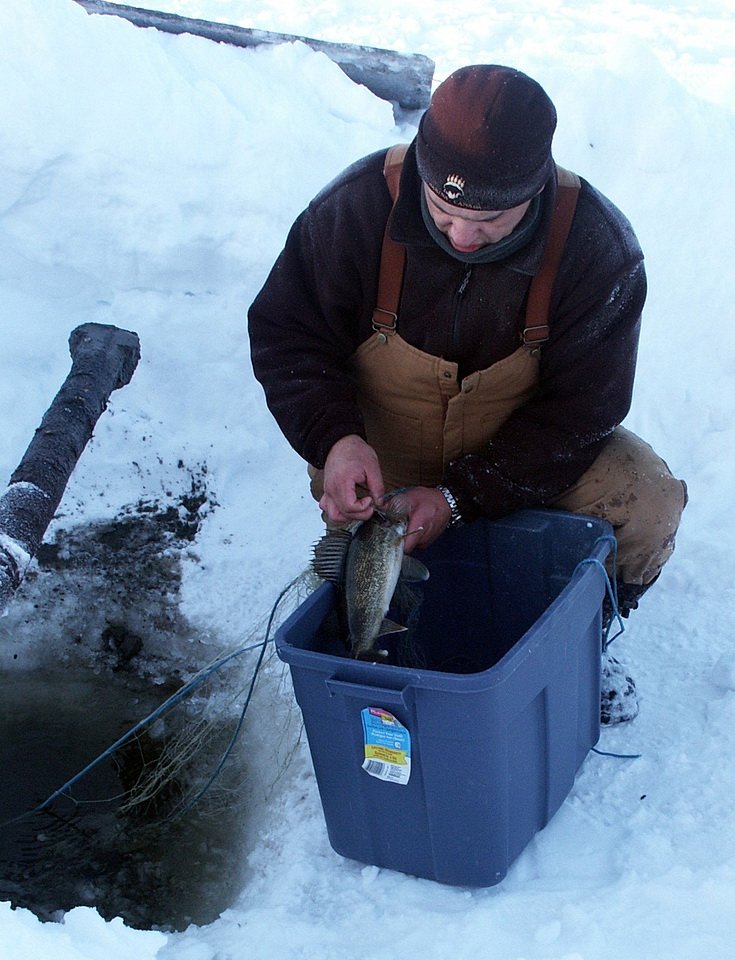Far North Friday #73: Iced Fisherman
It was a bright, sunny and very cold day. It was February 20, 2013. During our visit to the remote First Nation community of Fort Hope, Desmond Rainsford (Ontario Geological Survey Geophysical Science Leader) and I were invited by Brad Yesno (Eabametoong First Nation) to help pull in a gill net. The gill net was strung under the ice. It was time to harvest the fish.
For our community visit, we had not considered going out on the lake. So, not all of us were dressed to withstand the February wind chill on the lake. But, having received Brad’s offer to participate in an exciting and important fish harvest, it was an offer we couldn’t refuse. Ice fishing, northern style.
Brad drove the snow machine. I sat on the snow machine, behind Brad. Brad was an excellent wind screen. Des rode in the wooden sled pulled by the snow machine. Des did not have much of a wind screen (Photo 1). We headed out - bravely. The north wind was cold.
Photo 1: On our way to the gill net to harvest fish from Eabamet Lake. Brad Yesno (Eabametoong First Nation) is on the snow machine and Des Rainsford (Ontario Geological Survey) is in the wooden sled. Photo composed on a cold day, Eabamet Lake, in the homeland of Eabametoong First Nation, close to Fort Hope, Ontario, Feb. 20, 2003.
The first leg of the trip was to the Yesno homestead (Photo 2). We stopped to pick up some tools and get warm. Then, we mounted up and motored on to the net. Des sat again in the wooden sled, now surrounded by shovels, an axe, an ice chipper, spare rope, and several deep plastic bins to contain the bounty of harvested fish. The north wind was still cold.
Photo 2: Desmond Rainsford (left) and Brad Yesno (on the deck) at the Yesno homestead, which is located off-reserve, at the home of Andy Yesno. Andy Yesno, father of Brad Yesno, built the house with his family. The homestead was the location of a store, now long gone, that was operated by Andy’s Father. Andy’s grandfather was signatory to the 1905 Treaty #9. Andy has been one of my valuable mentors. Miigwetch Andy bezhig(1). Photo composed in the homeland of Eabametoong First Nation, close to Fort Hope, Ontario, Feb. 20, 2003.
The gill net was strung under the lake ice through two holes located about 50 feet apart. Our first task was to shovel off the layer of insulating snow that kept the water in the holes from refreezing (Photo 3). The north wind was cold.
Photo 3: Brad Yesno (left: Eabametoong First Nation) and Des Rainsford (right: Ontario Geological Survey) shoveling snow of the open holes through the ice on Eabamet Lake. The snow helps to minimize the refreezing of the holes through which the gill net is strung beneath the lake ice. Photo composed on a cold day, Eabamet Lake, in the homeland of Eabametoong First Nation, close to Fort Hope, Ontario, Feb. 20, 2003.
Brad tutored us on the art of harvesting fish from the gill net, while under the constant supervision of two ravens. Ravens are very smart. They know the locations of all the gill nets. When they see a snow machine heading across the lake toward the tell-tale tree stumps sticking out of a hole in the ice, they know their dinner is soon to be served. The ravens laughed at the cold north winds as they performed their aerial acrobatic display - always with an eye on the activity around the emerging gill net. It requires skills to string the gill net beneath the ice. It requires skill to remove the fish from the gill net without damaging the net (Photo 4). My job was to photograph and pull the long rope attached to the gill net to draw fish-laden net through the hole. It may not take as much skill to pull the net out, but I reminded myself that without my pulling, there would be no fish. I did feel a little vulnerable being alone, at the end of the long rope, so far away from Brad and Des. I felt I was an easy target for the hungry ravens. I secured my sunglasses to protect my eyes from attack, recalling that ravens went for the eyes first (just joking).
Photo 4: Brad Yesno (Eabametoong First Nation) teaching us the art and science of removing fish from the gill net in a way to ensure no damage to the net. Photo composed on a cold day, Eabamet Lake, in the homeland of Eabametoong First Nation, close to Fort Hope, Ontario, Feb. 20, 2003.
During the 2 hours we were at the gill net, I heard Brad check frequently with Des “are you OK”, “not too cold”, “you are looking a little red - sure you are OK”. I thought “why doesn’t Brad check on me?” “I guess I am too far away”. I looked at the black darts in the sky and secured my sunglasses again.
It was a successful harvest: lots of pickerel for the family; a different cultural experience outside the boardroom; and the raven attack was averted thanks to Brad’s generosity with the fish. We packed up and headed back to the Yesno homestead. The trip back should be warmer. After all, the wind was at our back - right? Well, not exactly. Travel on a snow machine comes with its own wind chill, regardless of the wind direction. After returning the tools to the Yesno homestead, Brad said, “Des, you look a little red and a little cold. Let’s go inside the house and warm up.”
We made it back to the reserve safely. It was cold. I often wondered if that was the coldest Des had been in his life (Photo 5). He was from England, where the coldest it gets is when you reach inside the freezer to take out dinner. Des never complained. He laughed and smiled. He worked hard. I hope he told his family, friends, and relatives about the adventure, in February, on Eabamet Lake, in remote northwestern Ontario, when the ice fishing trip nearly turned him into an iced fisherman. And miigwetch Brad for the experience and keeping an eye on us.
Photo 5: Des Rainsford (Ontario Geological Survey) holding up one of the well frozen pickerel (also known as walleye) that was harvested from the gill net. I wonder if Des was feeling as cold as the fish. Photo composed on a cold day, at the Yesno homestead, in the homeland of Eabametoong First Nation, close to Fort Hope, Ontario, Feb. 20, 2003.
Feb 4/22; Facebook: Feb 4/22





